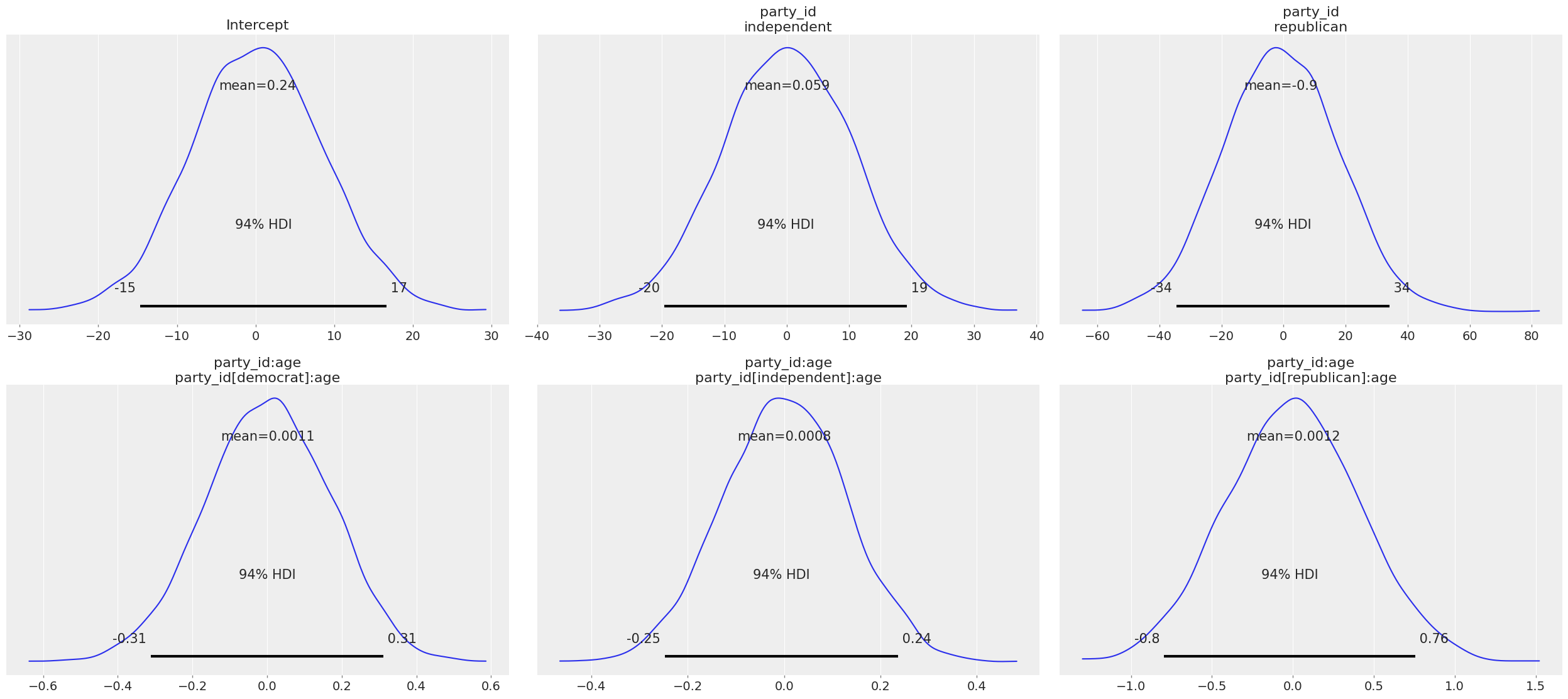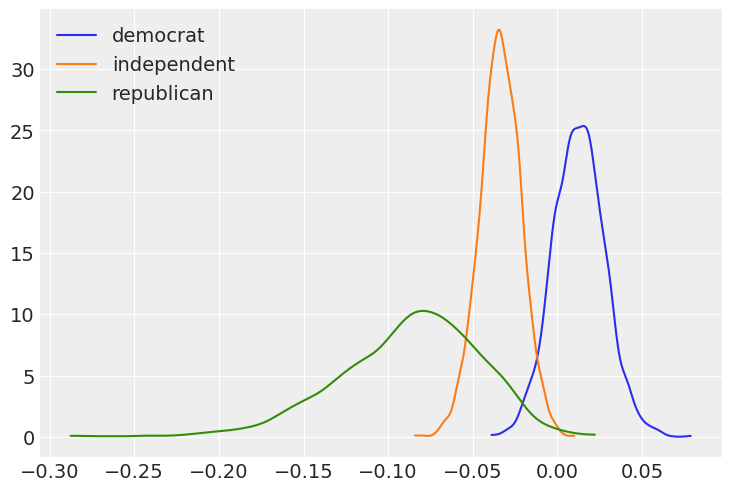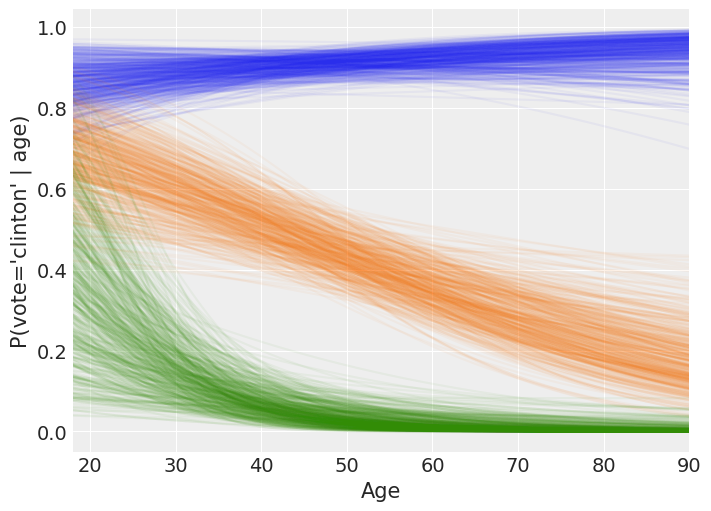Logistic Regression¶
[1]:
import arviz as az
import bambi as bmb
import matplotlib.pyplot as plt
import numpy as np
import pandas as pd
from scipy.special import expit as invlogit
[2]:
az.style.use('arviz-darkgrid')
np.random.seed(1234)
Load and examine American National Election Studies (ANES) data¶
These data are from the 2016 pilot study. The full study consisted of 1200 people, but here we’ve selected the subset of 487 people who responded to a question about whether they would vote for Hillary Clinton or Donald Trump.
[3]:
data = pd.read_csv('data/ANES_2016_pilot.csv')
data.head()
[3]:
| vote | age | party_id | |
|---|---|---|---|
| 0 | clinton | 56 | democrat |
| 1 | trump | 65 | republican |
| 2 | clinton | 80 | democrat |
| 3 | trump | 38 | republican |
| 4 | trump | 60 | republican |
Our outcome variable is vote, which gives peoples’ responses to the following question prompt:
“If the 2016 presidential election were between Hillary Clinton for the Democrats and Donald Trump for the Republicans, would you vote for Hillary Clinton, Donald Trump, someone else, or probably not vote?”
[4]:
data['vote'].value_counts()
[4]:
clinton 215
trump 158
someone_else 48
Name: vote, dtype: int64
The two predictors we’ll examine are a respondent’s age and their political party affiliation, party_id, which is their response to the following question prompt:
“Generally speaking, do you usually think of yourself as a Republican, a Democrat, an independent, or what?”
[5]:
data['party_id'].value_counts()
[5]:
democrat 186
independent 138
republican 97
Name: party_id, dtype: int64
These two predictors are somewhat correlated, but not all that much:
[6]:
fig, ax = plt.subplots(1, 3, figsize=(10, 4), sharey=True, constrained_layout=True)
key = dict(zip(data['party_id'].unique(), range(3)))
for label, df in data.groupby('party_id'):
ax[key[label]].hist(df['age'])
ax[key[label]].set_xlim([18, 90])
ax[key[label]].set_xlabel('Age')
ax[key[label]].set_ylabel('Frequency')
ax[key[label]].set_title(label)
ax[key[label]].axvline(df['age'].mean(), color='C1')

We can get a pretty clear idea of how party identification is related to voting intentions by just looking at a contingency table for these two variables:
[7]:
pd.crosstab(data['vote'], data['party_id'])
[7]:
| party_id | democrat | independent | republican |
|---|---|---|---|
| vote | |||
| clinton | 159 | 51 | 5 |
| someone_else | 10 | 22 | 16 |
| trump | 17 | 65 | 76 |
But our main question here will be: How is respondent age related to voting intentions, and is this relationship different for different party affiliations? For this we will use a logistic regression.
Build clinton_model¶
To keep this simple, let’s look at only the data from people who indicated that they would vote for either Clinton or Trump, and we’ll model the probability of voting for Clinton.
[8]:
clinton_data = data.loc[data['vote'].isin(['clinton', 'trump']), :]
clinton_data.head()
[8]:
| vote | age | party_id | |
|---|---|---|---|
| 0 | clinton | 56 | democrat |
| 1 | trump | 65 | republican |
| 2 | clinton | 80 | democrat |
| 3 | trump | 38 | republican |
| 4 | trump | 60 | republican |
Logistic regression¶
We’ll use a logistic regression model to estimate the probability of voting for Clinton as a function of age and party affiliation. We can think we have a response variable \(Y\) defined as
and we are interested in modelling \(\pi = P(Y = 1)\) (a.k.a. probability of success) based on two explanatory variables, age and party affiliation.
A logistic regression is a model that links the \(\text{logit}(\pi)\) to a linear combination of the predictors. In our example, we’re going to include a main effect for party affiliation and the interaction effect between party affiliation and age (i.e. we’ll have a different age slope for each affiliation). The mathematical equation for our model is
$ X_1 = :nbsphinx-math:`left`{
\right. \ X_2 = :nbsphinx-math:`left`{
\right. \ X_3 = :nbsphinx-math:`left`{
\right. \ X_4 = \text{Age} $
Notice we don’t have a main effect for \(X_3\). This happens because Democrat party affiliation is being taken as baseline and \(\beta_1\) and \(\beta_2\) represent deviations from that baseline. Thus, we see the main effect of Democrat affiliation is being represented by the Intercept, \(\beta_0\).
If we represent the right hand side of the model equation with \(\eta\), the expression can be re-arranged to express our probability of interest, \(\pi\), as a function of the linear predictor \(\eta\).
Since we’re Bayesian folks who draw samples from posteriors, we need to specify a prior for the parameters as well as a likelihood function before accomplishing our task. In this occasion, we’re going to use the default priors in Bambi and just note the likelihood is the product of \(n\) Bernoulli trials, \(\prod_{i=1}^{n}{p_i^y(1-p_i)^{1-y_i}}\) where \(p_i = P(Y=1)\) and \(y_i = 1\) if the vote intention is for Clinton and \(y_i = 0\) if Trump.
Specify and fit model in Bambi¶
Specifying and fitting the model is simple. Bambi is good and doesn’t ask us to translate all the math to code. We just need to specify our model using the formula syntax and pass the correct family argument. Notice the (optional) syntax that we use on the left-hand-side of the formula: We say vote[clinton] to instruct Bambi that we wish the model the probability that vote=='clinton', rather than the probability that vote=='trump'. If we leave this unspecified, Bambi will just
pick one of the events to model, but will inform you which one it picked when you build the model (and again when you look at model summaries).
On the right-hand-side of the formula we use pary_id + party_id:age to instruct Bambi that we want to use party_id and the interaction between party_id and age as the explanatory variables in the model.
[9]:
clinton_model = bmb.Model(clinton_data)
clinton_fitted = clinton_model.fit('vote[clinton] ~ party_id + party_id:age',
family='bernoulli', draws=2000)
/home/tomas/anaconda3/envs/bmb/lib/python3.8/site-packages/pandas/core/frame.py:3069: SettingWithCopyWarning:
A value is trying to be set on a copy of a slice from a DataFrame.
Try using .loc[row_indexer,col_indexer] = value instead
See the caveats in the documentation: https://pandas.pydata.org/pandas-docs/stable/user_guide/indexing.html#returning-a-view-versus-a-copy
self[k1] = value[k2]
Modeling the probability that vote==clinton
Auto-assigning NUTS sampler...
Initializing NUTS using jitter+adapt_diag...
Multiprocess sampling (2 chains in 2 jobs)
NUTS: [party_id:age, party_id, Intercept]
Sampling 2 chains for 1_000 tune and 2_000 draw iterations (2_000 + 4_000 draws total) took 15 seconds.
WARNING (theano.gof.compilelock): Overriding existing lock by dead process '9084' (I am process '8817')
To see the sensitive default priors Bambi has chosen for us, we just call Model.plot_priors().
[10]:
clinton_model.plot_priors();

Here we also inspect the parameters Bambi chosen for each prior.
[11]:
{x.name: x.prior.args for x in clinton_model.terms.values()}
[11]:
{'Intercept': {'mu': array(0.308043), 'sigma': array(8.39859892)},
'party_id': {'mu': array([0, 0]), 'sigma': array([10.51415445, 18.72417819])},
'party_id:age': {'mu': array([0, 0, 0]),
'sigma': array([0.16748696, 0.12909332, 0.40771782])}}
Under the hood, Bambi selected Gaussian priors for all the parameters in the model. By construction, all the priors, except the one for Intercept, are centered around 0, which is consistent with the desired weakly informative behavior. The standard deviation is specific to each parameter.
Some more info about these default priors can be found in this technical paper.
Now let’s check out the the results! We get traceplots and density estimates for the posteriors with az.plot_trace() and a summary of the posteriors with az.summary().
[12]:
az.plot_trace(clinton_fitted);

[13]:
az.summary(clinton_fitted)
[13]:
| mean | sd | hdi_3% | hdi_97% | mcse_mean | mcse_sd | ess_mean | ess_sd | ess_bulk | ess_tail | r_hat | |
|---|---|---|---|---|---|---|---|---|---|---|---|
| Intercept | 1.698 | 0.733 | 0.338 | 3.115 | 0.020 | 0.014 | 1349.0 | 1349.0 | 1343.0 | 1596.0 | 1.0 |
| party_id[0] | -0.284 | 0.959 | -2.127 | 1.460 | 0.026 | 0.018 | 1365.0 | 1365.0 | 1363.0 | 1421.0 | 1.0 |
| party_id[1] | -0.899 | 1.718 | -4.140 | 2.198 | 0.041 | 0.029 | 1770.0 | 1722.0 | 1793.0 | 1873.0 | 1.0 |
| party_id:age[0] | 0.013 | 0.015 | -0.015 | 0.043 | 0.000 | 0.000 | 1410.0 | 1185.0 | 1414.0 | 1725.0 | 1.0 |
| party_id:age[1] | -0.034 | 0.012 | -0.058 | -0.011 | 0.000 | 0.000 | 2160.0 | 2000.0 | 2183.0 | 1954.0 | 1.0 |
| party_id:age[2] | -0.087 | 0.042 | -0.165 | -0.015 | 0.001 | 0.001 | 1907.0 | 1612.0 | 2022.0 | 1655.0 | 1.0 |
Run Inference¶
Grab the posteriors samples of the age slopes for the three party_id categories.
[14]:
# We need to automatically add labels to InferenceData object to recover this by_label selection
parties = ['democrat', 'independent', 'republican']
party_idx = [0, 1, 2]
dem, ind, rep = [clinton_fitted.posterior['party_id:age'][:,:,x].values for x in party_idx]
Plot the marginal posteriors for the age slopes for the three political affiliations.
[15]:
fig, ax = plt.subplots()
for idx, x in enumerate([dem, ind, rep]):
az.plot_kde(x, label=f'{parties[idx]}', plot_kwargs={'color':f'C{idx}'}, ax = ax)
ax.legend(loc='upper left');

Now, using the joint posterior, we can answer our questions in terms of probabilities.
What is the probability that the Democrat slope is greater than the Republican slope?
[16]:
(dem > rep).mean()
[16]:
0.996
Probability that the Democrat slope is greater than the Independent slope?
[17]:
(dem > ind).mean()
[17]:
0.9955
Probability that the Independent slope is greater than the Republican slope?
[18]:
(ind > rep).mean()
[18]:
0.9115
Probability that the Democrat slope is greater than 0?
[19]:
(dem > 0).mean()
[19]:
0.79125
Probability that the Republican slope is less than 0?
[20]:
(rep < 0).mean()
[20]:
0.99425
Probability that the Independent slope is less than 0?
[21]:
(ind < 0).mean()
[21]:
0.998
If we look at the plot of the marginal posteriors, we may be suspicious that, for example, the probability that Democrat slope is greater than the Republican slope is 0.996 (almost 1!), given the overlap between the blue and green density functions. However, we can’t answer such a question using the marginal posteriors only, as shown in the plot. Since Democrat and Republican slopes (\(\beta_3\) and \(\beta_5\), respectively) are random variables, we need to use their joint distribution
to answer probability questions that involve both of them. The fact that logical comparisons (e.g. > in dem > ind) are performed elementwise ensures we’re using samples from the joint posterior as we should. We also note that when the question involves only one of the random variables, it is fine to use the marginal distribution (e.g. (rep < 0).mean()).
Finally, all these comments may have not been necessary since we didn’t need to mention anything about marginal or joint distributions when performing the calculations, we’ve just grabbed the samples and applied some basic math. But that’s an advantage of Bambi and the Bayesian approach. Things that are not so simple, became simpler :)
Spaghetti plot of model predictions¶
Here we separate results into two, one containing the intercept for each party_id, the other containing the age slopes for each party_id. Then we compute the linear predictor \(\eta\) for the different party affiliations and a sequence of age values, and plot the estimated values for \(\pi\) after passing \(\eta\) to invlogit().
[22]:
slopes = clinton_fitted.posterior['party_id:age'].values.reshape(4000, 3).T
[23]:
intercept_dem = clinton_fitted.posterior['Intercept'].squeeze().values.reshape(-1,)
intercept_ind = intercept_dem + clinton_fitted.posterior['party_id'][:,:,0].values.reshape(-1,)
intercept_rep = intercept_dem + clinton_fitted.posterior['party_id'][:,:,1].values.reshape(-1,)
intercepts = [intercept_dem, intercept_ind, intercept_rep]
Compute the predicted values for each posterior sample.
[24]:
X = np.hstack([np.array([1] * len(np.arange(18, 91)))[:, None], np.arange(18, 91)[:, None]])
yhat = [invlogit(np.dot(X, np.vstack([intercepts[i], slopes[i]]))) for i in range(3)]
Make the plot!
[25]:
_, axes = plt.subplots(figsize=(7, 5))
for i in range(3):
for t in range(500):
axes.plot(X[:, 1], yhat[i][:, t], alpha=0.05, color=f'C{i}')
axes.set_ylabel('P(vote=\'clinton\' | age)')
axes.set_xlabel('Age', fontsize=15)
axes.set_xlim(18, 90);

The following is a rough interpretation of the information contained in the plot we’ve just created.
According to our logistic model, the mean probability of voting for Clinton is almost always 0.8 or greater for Democrats no matter the age. Also, the older the person, the closer the mean probability of voting Clinton to 1.
On the other hand, Republicans have a non-zero probability of voting for Clinton when they are young, but it tends to zero for older persons. We can also note the high variability of P(vote = ‘Clinton’) for young Republicans. This reflects our high uncertainty when estimating this probability and it is due to the small amount of Republicans in that age range plus there are only 5 Republicans out of 97 voting for Clinton in the dataset.
Finally, the mean probability of voting Clinton for the independents is around 0.7 for the youngests and decreases towards 0.2 as they get older. Since the spread of the lines is similar along all the ages, we can conclude our uncertainty in this estimate is similar for all the age groups.
[26]:
%load_ext watermark
%watermark -n -u -v -iv -w
pandas 1.1.5
arviz 0.10.0
numpy 1.19.4
bambi 0.2.0
last updated: Fri Dec 11 2020
CPython 3.8.5
IPython 7.18.1
watermark 2.0.2